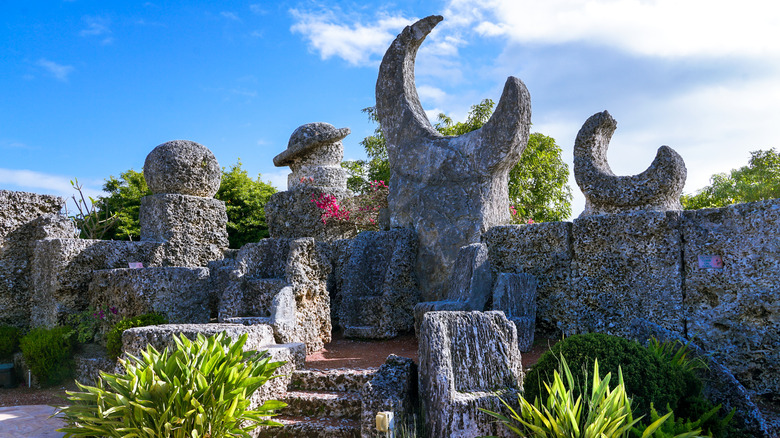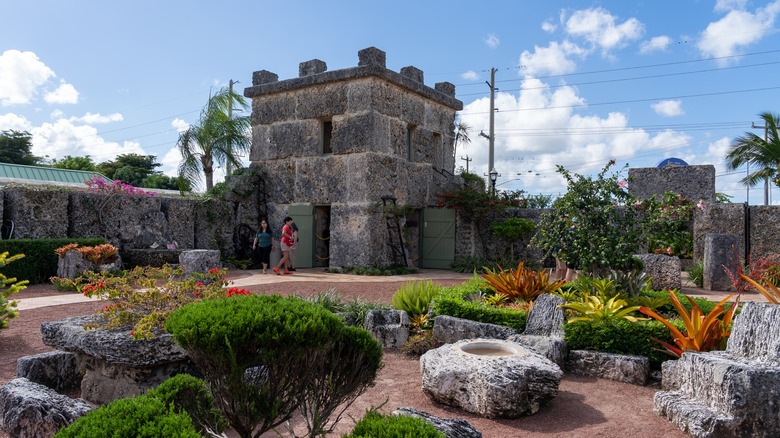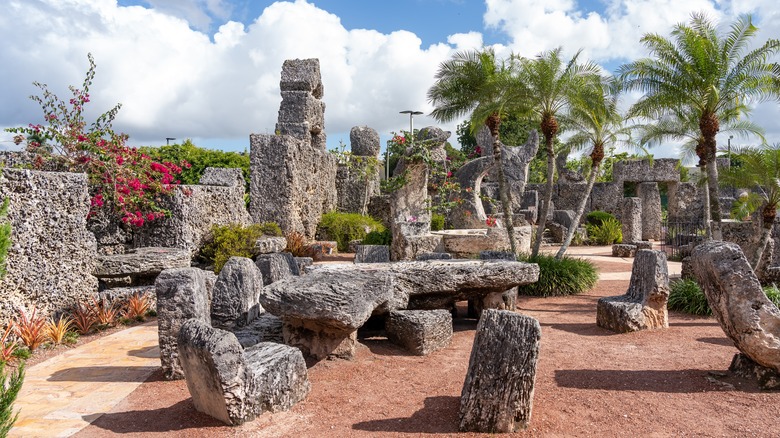Florida's Most Mysterious Structure Has A Dark History Born Out Of Broken Romance
The construction of Stonehenge and the Pyramids of Giza has puzzled people for centuries: How exactly could builders thousands of years ago pull off these incredible feats of engineering and elbow grease with only primitive technology? The answers are only just beginning to emerge. Over in Florida, there is a more modest, if in some ways just as impressive, monument with its own enigmatic origins. The Coral Castle in Homestead, Florida, is one of the most mysterious places in the world — even though we know it was the obsessive passion project of one person and the heartbreaking story behind it.
Coral Castle Museum and Sculpture Garden is a bizarre tourist attraction located on the South Dixie Highway, around a 45-minute drive south of Miami. It looks like an ancient megalithic mausoleum at first glance, but a closer inspection reveals a range of oddities hand-carved from the coral rock: a sundial, an obelisk, a heart-shaped table, throne-like rocking chairs, and a miraculous 3-ton stone gate balanced so precisely that it swings open at the lightest touch. The most remarkable thing is that it was all the work of one man, Latvian immigrant Ed Leedskalnin, and he built it not once but twice, later moving his carvings from their original site in Florida City to their present location in Homestead. But what drove Leedskalnin to create a monument like the Coral Castle, and how exactly did he achieve it? For the former, we have a story that could have been written by Edgar Allen Poe.
Why did Ed Leedskalnin build Coral Castle?
The exact details of Edward Leedskalnin and his Coral Castle are hazy and have become semi-mythical over the decades. Born in Latvia in 1887, the story goes that he fell in love at the age of 26 with a girl 10 years younger. She jilted him at the church altar in Riga — the failed romance is immortalized by Billy Idol in his hit song "Sweet Sixteen." Devastated, Leedskalnin immigrated to the United States where he worked as a lumberjack and a cowboy before he developed tuberculosis. He moved to the sunny climate of Florida for his health and, when he recovered, bought a plot of land where he could build an everlasting monument to his former love, which eventually opened in 1923.
The original site was in Florida City, and one story goes that he spent some time using a dowsing rod (a pseudoscientific instrument that is said to locate underground water, gems, and metals) to find the right spot. He set to work, initially calling his tribute Rock Gate after a 9-ton door that opened to reveal his oasis of carvings dedicated to the lover who spurned him. In 1936, he bought a new parcel of land 10 miles away in Homestead, and he spent the next three years moving his monument piece by piece. He made a modest income by giving tours and lived a solitary existence pining for his long-lost love, although he also found time to write a few strange books. When he passed away in 1951, the only people at his burial were the gravediggers.
How exactly was Coral Castle built?
Trying to figure out how exactly Ed Leedskalnin built Coral Castle has given the landmark an air of mystery over the decades. He was an enigmatic character, standing just 5 feet tall and weighing around 100 pounds. For many, it seems impossible that a diminutive tuberculosis survivor could have single-handedly quarried and manipulated over 1,000 tons of rock, turning it into huge sculptures weighing up to 30 tons. The equipment he used was basic, consisting largely of winches, ropes, pulleys, and a few tools. What was more, he worked in secrecy at night and never let anyone see how he achieved such incredible feats.
Naturally, the mystery has produced some outlandish theories, some of them perpetuated by Ed himself. He claimed to have harnessed the construction techniques of the ancient Egyptians, while others have suggested he used magnetism, levitation or ley lines to move the blocks. One of the most intriguing theories involves a perpetual motion device, due to Ed's application for a patent in the 1930s for something he called a magnetic generator. One more grounded solution is the use of compound pulleys, an ancient method of hoisting substantial weights. Ed came from a farming background and possibly learned the art of stonemasonry from his father, so it seems plausible that he was familiar with the technique. Whatever the method, nothing detracts from Ed's achievement: a labor of love that has outlived its creator and will enchant visitors for many years to come.


